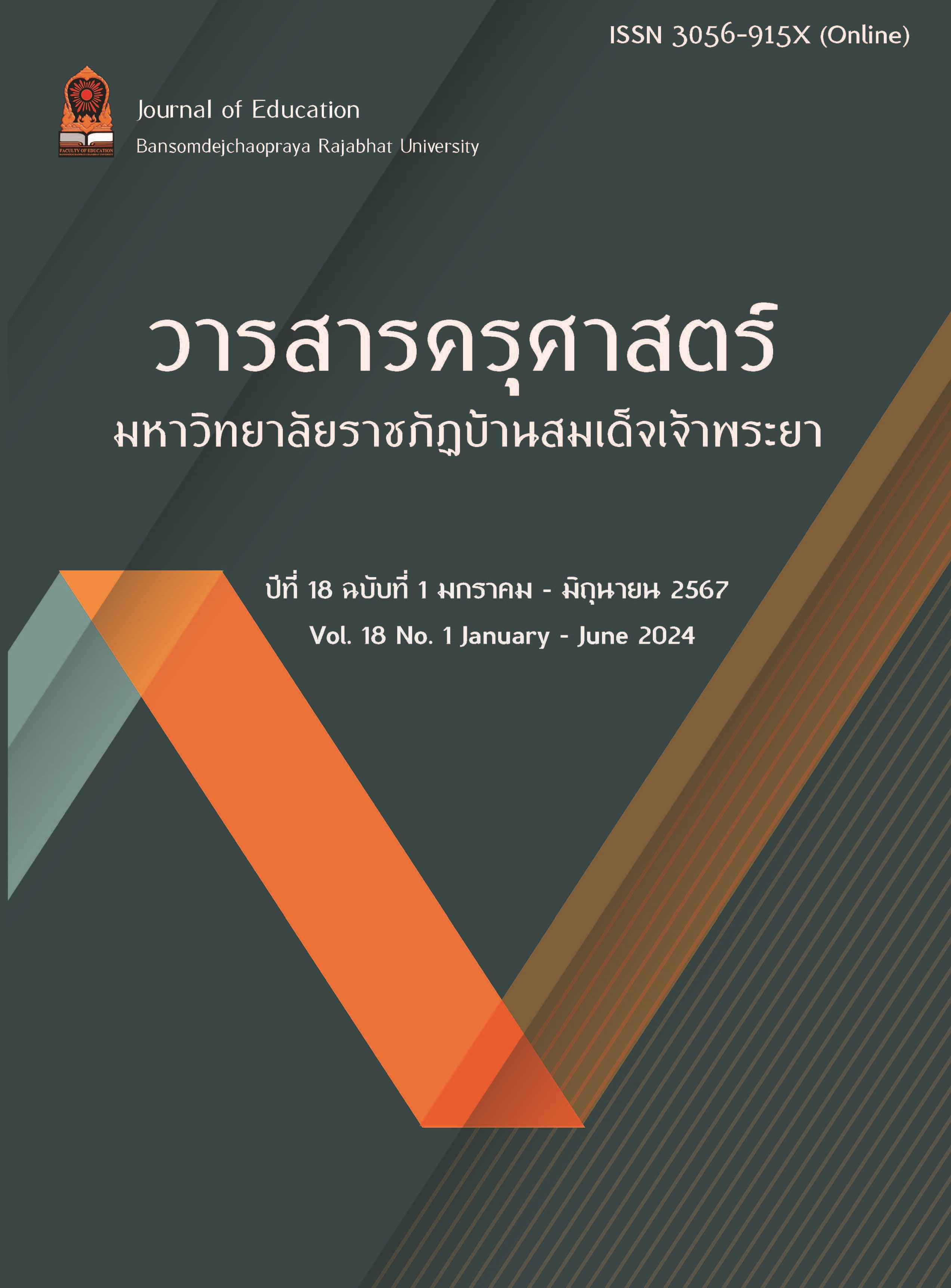Early Mathematics Concepts of Kindergarten 1 room 1 Students of Bansomdejchaopraya Rajabhat University Demonstration School (Early Childhood) through Play Activities
Keywords:
early childhood, early mathematics concepts, play activitiesAbstract
The aim of this research was to investigate and compare the early mathematics concepts of kindergarten 1 room 1 students of Bansomdejchaopraya Rajabhat University Demonstration School (Early Childhood) before and after their exposure to play activities. The research participants consisted of 17 male and female students aged 3 to 4 years old, enrolled in kindergarten 1 room 1, Semester 2, of the academic year 2023 at Bansomdejchaopraya Rajabhat University Demonstration School, affiliated with Bansomdejchaopraya Rajabhat University, located in Bangkok. The research employed the early mathematics concepts test and play activities learning lesson plans, utilizing a One-Group Pretest-Posttest design. Data analysis included the calculation of means, standard deviations, and mean difference between scores of each pair.
The results showed that the kindergarten 1 room 1 Students who underwent play activities exhibited significantly higher early mathematics concepts ( = 16.06). Their performance reached an excellent level (
= 23.65, percentage = 98.53%,
= 0.97). When examining specific aspects of early mathematics concepts, it was observed that the students' performance significantly improved, and they reached an excellent level in all aspects, which include: one-to-one correspondence (
=5.18,
=5.94, percentage =99.02%,
=0.24), classifying (
=4.53,
=6, percentage =100% ,
=0), comparing (
= 1.95,
=5.71 , percentage = 95.10% ,
=0.82), and seriation (
=4.41,
=6 percentage =100% ,
=0)
Downloads
References
ชญาภา สิงห์มหา. (2560). การพัฒนาทักษะพื้นฐานทางคณิตศาสตร์โดยใช้กิจกรรมศิลปะแบบบูรณาการสำหรับ
นักเรียนชั้นอนุบาลปี 2. (วิทยานิพนธ์ปริญญาการศึกษามหาบัณฑิตไม่ได้ตีพิมพ์) มหาวิทยาลัยมหาสารคาม.
ปัทมาวดี เล่ห์มงคล. (2556). แนวคิดทฤษฎีที่เกี่ยวข้องกับการเล่นของของเด็กปฐมวัย. ในเอกสารการสอนชุดวิชา การเล่น ของเล่น และเครื่องเล่นสำหรับเด็กปฐมวัย. (เล่ม 1, หน่วยที่ 1, น. 1-1 ถึง 1-44). นนทบุรี: มหาวิทยาลัยสุโขทัยธรรมาธิราช.
พัทยา เชี่ยววิชา. (2557). การใช้กิจกรรมการเล่นเพื่อพัฒนาทักษะพื้นฐานทางคณิตศาสตร์ของเด็กออทิสติก.
(การศึกษาค้นคว้าอิสระปริญญาศึกษาศาสตร์มหาบัณฑิตไม่ได้ตีพิมพ์) มหาวิทยาลัยเชียงใหม่.
เพ็ญจันทร์ เงียบประเสริฐ. (2542). คณิตศาสตร์สำหรับเด็กปฐมวัย. ม.ป.ป. ม.ป.พ
สถาบันราชานุกูล.(2557). การเตรียมความพร้อมทักษะพื้นฐานด้านคณิตศาสตร์ในเด็กปฐมวัย.กรุงเทพฯ: สถาบันราชานุกูล.
สถาบันส่งเสริมการสอนวิทยาศาสตร์และเทคโนโลยี. (2560). กรอบการเรียนรู้ และแนวทางการจัดประสบการณ์
การเรียนรู้บูรณาการ วิทยาศาสตร์ เทคโนโลยี และคณิตศาสตร์ในระดับปฐมวัย ตามหลักสูตรการศึกษาปฐมวัย พุทธศักราช 2560. กรุงเทพฯ: สถาบันส่งเสริมการสอนวิทยาศาสตร์และเทคโนโลยี
สำนักวิชาการและมาตรฐานการศึกษา. (2561). คู่มือหลักสูตรการศึกษาปฐมวัยพุทธศักราช 2560 สำหรับเด็กอายุ 3-6 ปี. กรุงเทพฯ: สำนักสำนักวิชาการและมาตรฐานการศึกษา.
Downloads
Published
How to Cite
Issue
Section
License
Copyright (c) 2024 Faculty of Educaion Bansomdejchaopraya Rajabhat University

This work is licensed under a Creative Commons Attribution-NonCommercial-NoDerivatives 4.0 International License.
บทความที่ได้รับการตีพิมพ์เป็นลิขสิทธิ์ของคณะครุศาสตร์ มหาวิทยาลัยราชภัฏบ้านสมเด็จเจ้าพระยา
ข้อความที่ปรากฏในบทความแต่ละเรื่องในวารสารวิชาการเล่มนี้เป็นความคิดเห็นส่วนตัวของผู้เขียนแต่ละท่านไม่เกี่ยวข้องกับมหาวิทยาลัยราชภัฏบ้านสมเด็จเจ้าพระยา และคณาจารย์ท่านอื่นๆในมหาวิทยาลัยฯ แต่อย่างใด ความรับผิดชอบองค์ประกอบทั้งหมดของบทความแต่ละเรื่องเป็นของผู้เขียนแต่ละท่าน หากมีความผิดพลาดใดๆ ผู้เขียนแต่ละท่านจะรับผิดชอบบทความของตนเอง


